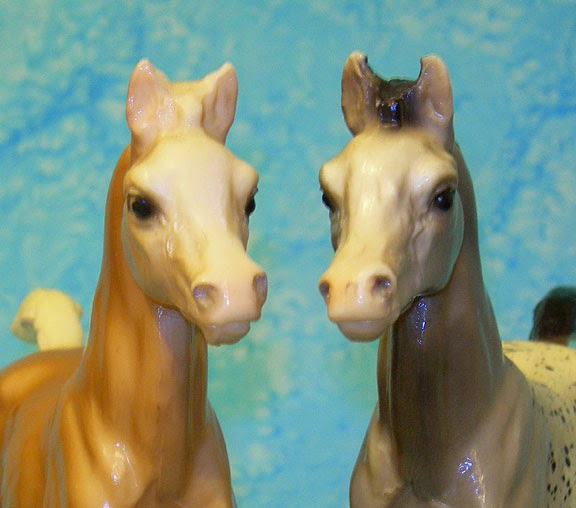The only thing that weirds me out a little is the scale. A little bit of that is about the dappling - that’s always been an issue with Stablemates - but mostly it’s the sticker. Was the scale of it off? If we scaled up both the Drafter and the sticker proportionately, until the sticker was the same size as the bigger "name" stickers used on the Traditionals, what size would Sonny be?
So I did the math: turns out that Sonny would be about Classics-scale, a little over six inches tall. So, not too bad.
There were two Classics-scale models that did receive Blue Ribbon Stickers during the Blue Ribbon Sticker Era of the late 1960s: the Bucking Bronco and the Rearing Stallion. The Bronco only received the small "number-only" version of the sticker, but Rearing Stallions can be found with either the bigger "named" stickers or the smaller "number-only" ones.
Back then, though, models weren’t broken out into scales. That didn’t happen until the mid-1970s, when the Hagen-Renaker molds were introduced. Even then, it took a while for those two molds to be reclassified as Classics, and not just diminutive Traditionals.
Physically, the smallest model of the Blue Ribbon Sticker Era to receive stickers wasn’t a Foal: it was the Bear Cub. Stickered Bear Cubs are not commonly found, but that’s because it's hard to keep a sticker stuck on a model with such a heavily textured coat. Other models with heavily textured coats tended to lose their stickers over time for the very same reason. (Good luck finding a Polled Hereford Bull with one!)
This isn’t the first time that stickers have been put on Stablemates, though. Shortly after the Stablemates molds were shipped to China in the early 1990s, they tried putting little gold "Made in China" stickers on the releases that followed.
That didn’t last long, either. I don’t know if the reason was a change in import regulations, or the fact that the stickum on the sticker didn’t stick very well. Annoying little buggers, regardless, and so far they haven’t merited much attention from hobbyists.
Well, back to tending my saleslist. I do have a few of my "better" items up on MH$P now, and will have a few more up by the end of Monday. Not sure exactly when; I’ll be in and out of the house all day with packing and shipping (busy sales weekend!) I’m crossing my fingers that Reeves doesn’t pull any crazy Cyber Monday surprises on us...













